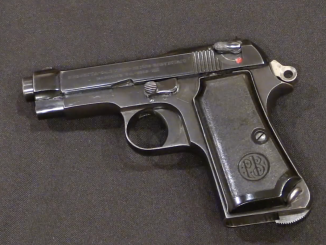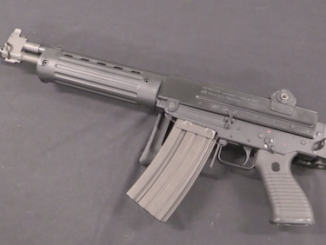We have blogged about the Cei-Rigotti before, but I figured I’d do a re-cap on it, considering the new information we’ve found on its caliber. I’ve also uploaded a gallery of photos of the rifle and its parts, which you can see at the bottom of this post (and on the new Cei-Rigotti page in the Vault).
Amerigo Cei-Rigotti was a major in the Italian Bersaglieri (light infantry) in 1900, when his innovative self-loading rifle design was first introduced. Unlike many or the very early semiauto rifle designs, the Cei-Rigotti is a light, handy, and pretty compact rifle:

The rifle was select-fire and shared the size and style of the Carcano as well as a few small parts, but was built from the ground up and was not a conversion of a bolt action rifle. It operated via gas pressure on a short-stroke piston under the barrel. This example has a small magazine, but several different sizes were used in various tests, reportedly up to 50 rounds in capacity. The magazines are not quick-detachable, though, and must be reloaded with stripper clips through the receiver. Removing the magazine requires removing the trigger guard assembly first (see video below).

Another unusual feature of the Cei Rigotti is that its trigger extends down through a slot in the trigger guard. The purpose of this is not clear – is does not appear to be related to the select-fire nature of the rifle, as there is a selector switch on the left rear of the receiver to change for single shots to automatic fire. This leaves a “winter trigger” idea as the most likely answer.

What little literature was have found on the Cei-Rigotti always describes it as being chambered for 6.5mm Carcano, but this is not the case. The one Cei-Rigotti we are aware of in the US is actually chambered for 7.65×53, which was one of Mauser’s major caliber offerings at the time the Cei-Rigotti was being conceived. The Pattern Room collection in the UK has serial number 7, and theirs is also chambered for the 7.65×53 cartridge (we really appreciate them checking on it and letting us know). It is unknown at this point whether all of the handful of prototypes built were in this chambering, or if they were made in several different calibers (possibly including 6.5 Carcano) for testing in different nations.
Ultimately, the Cei-Rigotti was not adopted by any military force despite being tested by several countries over the decade after its introduction. Most folks today say this was due to erratic and unreliable functioning, but we have not seen any test reports from the period substantiating this (and the mechanism seems quite sound to us). The test conducted by the British, for instance, appears to have been run with ammunition that was shipped with the rifle and damaged in transit.
This Cei-Rigotti (the same one as our video above) is in a museum collection in England, and is missing its internal bolt parts, unfortunately. We have not been able to confirm its caliber yet.
[nggallery id=171]




It would have been easier to control, at least in full-auto, 6.5mm Carcano. That’s presumably (along with feeding issues) why the Federov was chambered for 6.5mm Arisaka.
It looks like a decent little gun. If it worked and had been issued in quantity, I wonder how it might have changed things on the Isonzo…
Originally, the Fedorov was chambered for a 6.5mm cartridge of Fedorov’s own design. The reason the Fedorov was re-chambered to 6.5mm Arisaka was that when the gun was taken into service in WWI, no one was producing Fedorov’s cartridge. So the easiest way to get it into service was to install a chamber insert to change the caliber to 6.5mm Arisaka, which was in abundance having been purchased from Great Britain and Japan.
Any chance you can fire this? At least it would give some impressions.
Probably not, unfortunately. Of the two we’ve laid our hands on, both are in museum collections and one has a broken recoil spring while the other is missing its firing pin. The only possibility I can see it the one in the US, and we’ve never spoken to its owners so I don’t know if they have any interest in shooting it.
I’m guessing there’s no chance that the museums would be willing to temporarily swap the broken parts to make their guns temporarily shootable either.
Actually, we do indeed substitute parts for test firing. But in this case, as we have only one example, and it’s an especially rare type, I don’t think we could justify the risk.
Trigger extenion through the Trigger Guard should
be a safety measure for taking the gun on just “Let
Off” position with a trigger depressed to the point
where necessary security back travel taken up. If
noticed, Trigger Guard has a limitation for trigger
backward travel to reach to the release point.
The trigger extension as a winter trigger doesn’t make much sense. If the extension would fire the weapon, you may as well not have a trigger guard at all. There’s a spur on the trigger guard which looks like it may have been intended to prevent the trigger from being depressed far enough to fire.
Also, the extension looks rather small for a winter trigger. A winter trigger is usually used with mittens, since a normal glove (or a mit with a separate trigger finger) would fit through a regular (or enlarged) trigger guard. Trying to operate that small spur with a thick set of mits doesn’t look like it would be easy.
I think that someone needs to examine the mechanism in detail to determine what that feature is for. I would not be surprised if it was some minor feature that was clever, but not really very useful in practice.
The exposed action on the rifle does look like it would be a rather alarming thing to fire however. It would also be likely to pick up dirt quickly. I imagine that and the cost would have deterred most military customers.
strongarm beat me to it, but I can confirm from testing our example that the extended trigger is for releasing the bolt forward – the shape of the guard prevents the trigger from returning far enough to the rear to fire the gun, but far enough to send the bolt home, Ljungmann style. With finger in the guard, there’s no stop in the way of your finger, and the rifle can be fired.
Jonathan